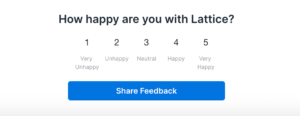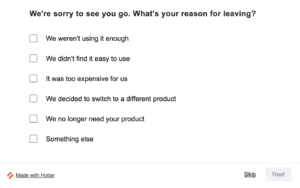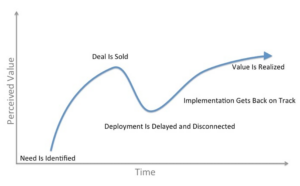Net Promoter Score (NPS) is a simple metric to measure customer loyalty. It asks a customer to rate how likely they are to recommend your product or service to their family and friends, using a scale of zero to ten.
Since it was introduced in 2003, NPS has been adopted by leading companies across industries as a quantitative way to evaluate customer sentiment. But here’s the thing: NPS doesn’t reflect actual customer behavior.
When Harvard Business School conducted a qualitative survey of customers to supplement their understanding of NPS, they found that about 52% of people who answer an NPS survey will actively promote and actively criticize a brand at the same time. For example, a consumer may be a regular customer at an outdoor retailer and answer favorably on NPS surveys, but actively discourage a more fashionable friend from purchasing clothing there.
Humans are complicated. Their feelings about brands are mutable, and may depend on the person they are talking to or the product being discussed. Relying exclusively on NPS can give brands a skewed idea of what makes their customers happy.
An NPS survey asks customers the likelihood that they will recommend a product. But there’s a major limitation of NPS — it does not measure any action a customer actually makes. Source: ReallyGoodEmails.com/Medium
While NPS scores can be helpful guideposts, they are not all-encompassing, and brands seeking to improve customer sentiment should look deeper than this one metric.
Fortunately, alternatives to NPS are available that focus on actual customer behaviors, like customer retention rates and whether a customer enjoys using your products.
Here, we break down 9 of the most helpful metrics for marketers and business owners to understand customer behavior and measure loyalty beyond NPS.
1. Customer Effort Score (CES)
Customer Effort Score (CES) tells you if customers have a hard time performing certain actions with your brand, like navigating through online check-out or contacting a customer service representative.
While it may look similar to NPS in format, CES measures the amount of effort a customer actually has to exert to get something done with your company. It’s not a hypothetical metric — the feedback you receive is based on real customer experiences.
Usually, brands calculate CES by sending a customer a survey just after they perform an action with your brand. In that survey, ask “How easy was it to complete your purchase?” (or another desired action) and follow with a scale of answers ranging from “Very easy” to “Very difficult.” Some brands even use emojis instead of word-based responses.
Source: HubSpot.com
To measure CES, collect survey feedback over a period of time (a month, a quarter, or any time period of your choice). The above image is a useful example because it keeps the data simple with only three values: negative, neutral, and positive.
Then, total your highest responses (e.g., Easy and Very easy) and divide the number of positive responses by the total number of responses. Multiply by 100.
Number of positive responses / Total number of responses × 100 = CES
For example, if you collected 500 responses over a month and had 150 positive responses, your CES would be 30:
(150 / 500) × 100 = 30 CES
There is no industry standard to define a “good” CES. This is a metric you can define for your own company. For example, if your company is trying to mend a poor reputation for customer service, an increasing CES of 30 might be good news — while for another company, it would represent a backslide.
2. Customer Satisfaction Score (CSAT)
Customer Satisfaction Score (CSAT) is a straightforward way to find out just how satisfied your customers are with your company.
CSAT is used at the very end of a customer’s interaction with a brand, closing the loop on their experience. Unlike NPS, which measures the likelihood of customer loyalty, CSAT is based on actual customer sentiment.
CSAT is a metric used to measure customer satisfaction levels with your brand, like in this example from Lattice.
Source: Lattice.com
CSAT is calculated using the same formula as CES. What makes it different is the question you ask. Rather than gauging the customer’s effort to get something done with your brand, CSAT measures customer happiness.
Send customers a short, one-question survey to measure your CSAT score. Ask, “How happy are you with [brand name]?” Collect survey feedback over a period of time (a week, a month, a quarter, or any time period of your choice).
Then, add up your highest responses (e.g., Happy and Very happy) and divide the number of positive responses by the total number of responses. Multiply that number by 100 to get your CSAT.
Number of positive responses / Total number of responses × 100 = CSAT
For example, if you collected a total of 300 responses with 180 positive responses, your CSAT would be 60:
(180 / 300) × 100 = 60 CSAT
There are industry standards that define a “good” CSAT score. Scores can range from 0 to 100, and generally, you want your score to be as close to 100 as possible. The American Customer Satisfaction Index keeps an up-to-date list of CSAT scores. Here are a few industry benchmarks from 2025:
- Online retail: 79
- Full-service restaurants: 84
- Lodging: 77
- Credit Unions: 79
- Internet Service Providers: 71
- Subscription TV service: 70
One way to make your customers happier is to launch a refer-a-friend program and reward brand advocates. Whether it’s a discount or a free shipping offer, referral rewards are a great way to make customers feel appreciated and nurture loyalty.
Learn more in Extole’s 2025 guide to referral marketing best practices.
3. Customer Retention Rate (CRR)
Customer Retention Rate (CRR) is a metric used to measure how many customers your company can keep over time.
This metric is a valuable alternative to NPS because it shows exactly how many customers you’re able to retain.
Customer acquisition costs have risen significantly over the past decade — as much as 75% in some industries — and are only going to increase with time. Calculating your CRR is helpful to shift the focus from acquiring new customers to retaining existing customers. In the long run, this strategy saves you money.
CRR accounts for three factors: the number of customers you started with, the number you added over a period of time, and the number you ended with.
To get started, you need to choose a period of time to examine. This can be a month, a quarter, or any length of time of your choosing.
This metric is calculated by subtracting the number of new customers from that period from the number of customers at the end of the period, then dividing that number by the number of customers at the start of that period. Multiply that number by 100 to get your CRR.
(Number of period-end customers – Number of period-added customers) / Number of period-start customers × 100 = CRR
For example, if you started with 50 customers, added 60, but ultimately ended with 80, your CRR would look like this:
(80 – 60) / 50 × 100 = 40% CRR
A “good” CRR varies by industry, but the higher the better. Here are the 2025 industry benchmarks for retention rate, compiled by CustomerGauge:
- Consumer packaged goods: 60%
- Industry services: 83%
- Financial services: 81%
- Energy and utilities: 89%
- Telecommunications: 69%
- Computer software: 86%
- Manufacturing: 65%
4. Customer Lifetime Value (LTV)
Customer Lifetime Value tells you the amount of revenue your company has gained from your customers. You can calculate it based on a single customer or a customer segment.
Unlike NPS, which only looks at the likelihood that a customer will refer your brand to a friend, shows the real financial impact a customer has made on your company over time. It’s a tangible metric that’s a strong indicator of customer loyalty and satisfaction.
To calculate LTV, multiply customer value by the average customer lifespan.
Customer value × Average customer lifespan = LTV
To get your customer value, you need to find your company’s average purchase value and multiply that number by the average number of purchases. Your average customer lifespan is the average number of years you retain customers.
Let’s work through an example, starting with finding your customer value. Say your company’s average purchase value is $25, and your customers average 10 purchases with you over their lifetime. Your customer value is 250.
If your average customer lifespan is 12 years, multiply that number by 250. Your LTV for that customer is $3,000.
$250 × 12 = $3,000 LTV
LTV is useful for any B2B or B2C brand, but it’s particularly useful for companies with subscription-based products or services — whether it’s a video streaming service or a monthly meal-delivery kit.
This metric will point out trends across a multi-year relationship with a customer. It’ll also show you churn risks if you see sustained dips in revenue over time.
5. Churn Survey
A churn survey collects insightful data about the factors that drive customers to stop using your products or services. It shines a light on how both internal and external factors impact customer behavior.
While some customers churn due to reasons you have no control over, many also leave as a result of issues you can remedy.
Causes of customer churn include:
- Frustrating user experience
- Poor onboarding process
- Unresponsive customer service
- Unmet goals or expectations
When designing a churn survey, keep in mind that customers might have little patience for lengthy questionnaires or Zoom meetings. The survey should be brief while collecting the most important metrics.
An example of a customer churn survey. Source: Hotjar
Deliver the survey using the channel customers are most likely to use. For example, you can send it by email or display it as a pop-up on your website.
Once you identify issues that erode the customer relationship, you can brainstorm a strategy to fix them.
6. Post-purchase Survey
A post-purchase survey helps you understand:
- The reasons customers make a purchase
- The marketing channels that led them to your brand
- Any friction points that occurred during the shopping experience
And anything else you want to know about the purchasing process so you can improve it.
It’s important to display this survey immediately after the customer completes the purchase because the experience is still fresh in their mind, and because they’re more likely to fill out the survey then.
Keep the survey brief, using a mix of open-ended and multiple-choice questions to gather as many insights as possible.
In the example below, the survey largely consists of multiple-choice questions that require little effort. Only the final question is open-ended.
A post-purchase survey by Mysa Smart Thermostats. Source: ConvertFlow
Consider adding an incentive such as free shipping to get more responses and encourage customers to make a repeat purchase.
7. Product Engagement Score (PES)
The Product Engagement Score (PES) measures user interaction with a software product. It allows businesses to measure their product performance and how customers engage with it.
To calculate PES, we need the following metrics:
- Adoption: The average number of features (core events) adopted by active accounts
- Stickiness: The percentage of monthly or weekly active users who use the product daily
- Growth: The number of new and recovered users or accounts (growth) divided by the number of users lost (churn)
Once you’ve calculated these metrics, use the PES formula to measure the performance of your product.
Adoption rate + stickiness + growth rate / 3 = PES
By continually monitoring your PES, you can get valuable insights that will help you iterate and improve your product over time. Deconstructing the score provides further observations, such as which metric needs the most attention, or which has changed the most over a given time period. Improving one of the three metrics could be enough to bring your PES score to your ideal range.
It’s also helpful to calculate PES for different user segments. For example, users between the ages of 20 and 30 might use your product differently than those in the 40 to 50 age group. The more granular you get, the more valuable insights you’ll glean from your PES calculations.
8. Time to Value (TTV)
Time to Value (TTV) is another useful metric for analyzing customer experience. It refers to the amount of time it takes customers to get value from your product, or to put it another way, how quickly customers get a return on their investment.
A graph depicting the relationship between time and value for a hypothetical product. Source: Bare Metrics
TTV calculations may look different from one company to another. The first step is to define the following variables:
- Value – What is the primary value customers are looking to get from your product? Try to see it from a user perspective. As an example, a social media app might define this as the first time a user posts a video, or the first time a user interacts with a video.
- Start Point – From what moment do you begin measuring whether a customer has received value from your product? This could be once they purchase the product, open an account, finish onboarding, etc.
- End Point – What action or outcome indicates that a customer has reached your predetermined value?
Taking these variables into account, the formula looks like:
End point (value realized) – start point = TTV
Given the flexibility of TTV as a metric–there is no set definition of “value,” “start,” or “end”–there are also no generally accepted industry benchmarks. The best piece of advice regarding TTV is to aim for as small a number as possible. Particularly in a consumer landscape where so many options are available for virtually every product and service, consumers usually expect to start seeing value soon after purchase–or they might begin to regret their decision.
Soliciting customer feedback that can supplement your TTV is a critical step in identifying ways to improve it. Maybe your definition of “value” is misaligned with your customers’ expectations. If so, reorient your goals towards prioritizing whatever value the customer is most hoping to receive. In doing so, you’ll not only shorten your TTV, you might also improve your customer satisfaction (CSAT) and customer retention rate (CRR).
9. Social Media Sentiment Analysis
Social Media Sentiment Analysis is a relatively new method of compiling and analyzing consumer attitudes towards your brand via online activity such as likes, comments, shares, and mentions on social media. This usually requires the use of an external tool that uses natural language processing to evaluate posts across the internet and identify themes in how your brand is perceived and discussed.
After categorizing terms as either positive or negative, social media sentiment is expressed as a percentage indicating the percent of consumer sentiment that is positive based on an analysis of content across the internet.
There are, of course, insights to be gleaned beyond a singular percentage. Keeping an eye on social media sentiment can help you identify trends in sentiment, peaks and valleys following important brand decisions, and differences in sentiment between platforms.
Having advocates who speak positively about your brand online is a powerful and low-cost channel for new customer acquisition. Prioritizing customer engagement and satisfaction is one way to improve sentiment online. Rewarding loyal customers shows them how much you value their business, which is often reciprocated in their interactions with your brand online.
Extole’s referral marketing platform helps brands reach their online brand advocates and reward them for referring friends and family members, creating a powerful growth channel.
Get More Insights Into Customer Behavior With a Referral Program
When you launch a referral program using Extole’s customer engagement platform, you’ll get the opportunity to gather more data about your audience’s behavior.
Extole’s sophisticated reporting and analytics tools compile data on referral share rates, advocate relationships, audience segment performance, and more. Use this data to personalize marketing and build a stronger relationship with your customers.
Alternatives to NPS FAQs
What Are Some Alternatives to NPS?
You can use the following metrics to measure customer sentiment and behavior:
- Customer effort score
- Customer satisfaction score
- Customer retention rate
- Customer lifetime value
- Product engagement score
- Time to value
- Social media sentiment
Additionally, consider running various surveys such as churn or post-purchase to collect more behavioral data at critical points of the customer journey.
Is CSAT or NPS Better?
CSAT and NPS have different goals. While CSAT measures customer happiness, NPS quantifies loyalty. Therefore, neither is better than the other.
Is NPS Outdated?
Some marketers believe NPS is an outdated metric because it’s too general and doesn’t provide enough insights into the customer’s experience or journey.
Janelle Dieken, the Senior Vice President of Marketing at Genesys, explains that NPS helps measure whether a business has met consumer expectations, as long as the results are positive. However, the metric is less effective when the results are negative because it gives little insight into what went wrong.
What Is NPS 3.0?
The original creator of the Net Promoter Score, Fred Reichheld, recently developed the NPS 3.0 to address the misuse and misunderstanding of the original NPS. The upgraded NPS 3.0 urges brands to consider a metric complementary to NPS called “earned growth rate”. This metric uses actual business results to highlight the quality and profitability of a brand’s growth when that growth is derived from an engaged customer base. It compares “earned customers” with their counterparts, “bought customers,” and highlights the amount of growth that comes from the former instead of the latter.
But rather than rely on the potentially biased sample of customers who respond to NPS surveys, earned growth is based on the specific, measured revenues from all existing customers. NPS 3.0 is far more resistant to gaming, coaching, pleading, and the response biases associated with the results of non-anonymized NPS surveys.
NPS 3.0 is far more comprehensive than its older counterpart, but it is still stronger when supplemented by one or more of the metrics recommended in this article. The more data you have on customer behavior and sentiment, the more strategic you can be about improving your product and increasing customer retention and value.










